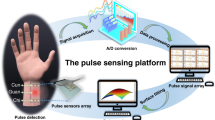Abstract
Objective
To collect and analyze multi-dimensional pulse diagram features with the array sensor of a pressure profile system (PPS) and study the characteristic parameters of the new multi-dimensional pulse diagram by pulse diagram analysis technology.
Methods
The pulse signals at the Guan position of left wrist were acquired from 105 volunteers at the Shanghai University of Traditional Chinese Medicine. We obtained the pulse data using an array sensor with 3×4 channels. Three dimensional pulse diagrams were constructed for the validated pulse data, and the array pulse volume (APV) parameter was computed by a linear interpolation algorithm. The APV differences among normal pulse (NP), wiry pulse (WP) and slippery pulse (SP) were analyzed using one-way analysis of variance. The coefficients of variation (CV) were calculated for WP, SP and NP.
Results
The APV difference between WP and NP in the 105 volunteers was statistically significant (6.26±0.28 vs. 6.04±0.36, P=0.048), as well as the difference between WP and SP (6.26±0.28 vs. 6.07±0.46, P=0.049). However, no statistically significant difference was found between NP and SP (P=0.75). WP showed a similar CV (4.47%) to those of NP (5.96%) and SP (7.58%).
Conclusion
The new parameter APV could differentiate between NP or SP and WP. Accordingly, APV could be considered an useful parameter for the analysis of array pulse diagrams in Chinese medicine.
Similar content being viewed by others
References
Xu JT. The editorial and prospective of Chinese medicine health evaluation systems studies based on four diagnostic information and decision support. Chin J Integr Tradit West Med (Chin) 2012;32:307–310.
Fei ZF. Advances in pulse instrument and thoughts on 'Cunkou' pulse condition. Acta Univ Tradit Med Shanghai (Chin) 2012;26:7–10.
Yang J, Niu X. Ultrasound–videotex detection on 3 dimensional movement of radial artery on Cunkou. Chin J Tradit Chin Med Phar (Chin) 2006;21:264–266.
Chen JX, Liu F. Research on characteristics of pulse delineation in TCM and omnidirectional pulse detecting by electro–pulsograph. In: IEEE international symposium on IT in medicine and education. Xiamen, China: IEEE; 2008:536–538.
Wu HK, Ko YS, Lin YS, Wu HT, Tsai TH, Chang HH. The correlation between pulse diagnosis and constitution identification in traditional Chinese medicine. Complement Ther Med 2017;30:107–112.
Sha H, Niu X, Wei J, Zhao S, Wang Y, Wang L. A flexible pulse detecting probe based on pressure sensor array. Chinese Patent No. CN201248702(Y), 2009.
Lee T, Shin K, Yoo S. A case control study to evaluate abnormal lipid profiles in elderly Koreans using radial artery pulse signals. Eur J Integr Med 2013;5:332–338.
http://www.omronhealthcare.com.cn/Home/Company/news_detail/id/133. Access 2017,11,20.
https://pressureprofile.com/pulse–sensor–development#pulsepressure–wave form. Access 2017,11,20.
Zhang AH, Li YP, Yu D, Guo WG. Pulse signals detection by digital image correlation. In: 2008 International Conference on BioMedical Engineering and Informatics. Sanya: IEEE; 2008:218–222.
Pang C, Lee GY, Kim TI, Kim SM, Kim HN, Ahn SH, et al. A flexible and highly sensitive strain–gauge sensor using reversible interlocking of nanofibres. Nat Mater 2012;11:795–801.
Wang X, Gu Y, Xiong Z, Cui Z, Zhang T. Silk–molded flexible, ultrasensitive, and highly stable electronic skin for monitoring human physiological signals. Adv Mater 2014;26:1336–1342.
Luo CH, Chung YF, Yeh CC, Si XC, Chang CC, Hu CS, et al. Stringlike pulse quantification study by pulse wave in 3D pulse mapping. J Altern Complem Med 2012;18:924–931.
Luo CH, Chung YF, Hu CS, Yeh CC, Si XC, Feng DH, et al. Possibility of quantifying TCM finger–reading sensations: I. Bi–sensing pulse diagnosis instrument. Eur J Integr Med 2012;4:e255–e262.
Chung YF, Hu CS, Luo CH, Yeh CC, Si XC, Feng DH, et al. Possibility of quantifying TCM finger–reading sensations: I. An example of health standardization. Eur J Integr Med 2012;4:e263–e270.
Chung YF, Hu CS, Yeh CC, Luo CH. How to standardize the pulse–taking method of traditional Chinese medicine pulse diagnosis. Comput Biol Med 2013;43:342–349.
Chu YW, Luo CH, Chung YF, Hu CS, Yeh CC. Using an array sensor to determine differences in pulse diagnosis—three positions and nine indicators. Eur J Integr Med 2014;6:516–523.
Hu X, Zhu H, Xu J, Xu D, Dong J. Wrist pulse signals analysis based on deep convolutional neural Networks. In: IEEE conference on computational intelligence in bioinformatics and computational biology. Honolulu, USA: IEEE; 2014:1–7.
Hu XJ. The research on signal perception and computer aided recognition of traditional Chinese medicine pulse diagnosis [dissertation]. Shanghai: East China Normal University; 2012.
Fei ZF. Study on modern Chinese pulse diagnosis. Beijing: People's Medical Publishing House; 2003:162–165.
Cui J, Xu JT, Di Z, Tu LP, Cui LT, Chen QG, et al. Analysis of pulse index of college students with sub–health state intervened by herbal prescriptions. Chin J Tradit Chin Med Phar (Chin) 2013;5:1564–1567.
Xu JT, Tu LP, Di Z, Chen Y, Chen QG, Zhang L, et al. Information from four examinations and classification by syndrome differentiation in sub–health status. J Beijing Univ Tradit Chin Med (Chin) 2011; 34:741–750.
Acknowledgement
The authors thank all volunteers for their pulse data.
Author information
Authors and Affiliations
Corresponding author
Additional information
Supported by the National "Twelfth Five-Year" Plan for Science and Technology Support (No. 2012BAI37B06), the National Natural Science Foundations of China(No. 81173200, 81373556), the Shanghai Municipal Commission of Health and Family Planning of Science and Technology Innovation Project (No. ZYKC201602003) and the Shanghai Municipal Education Commission of Science and Technology Project (No. 2016YSN02)
Electronic supplementary material
Rights and permissions
About this article
Cite this article
Cui, J., Tu, Lp., Zhang, Jf. et al. Analysis of Pulse Signals Based on Array Pulse Volume. Chin. J. Integr. Med. 25, 103–107 (2019). https://doi.org/10.1007/s11655-018-2776-y
Accepted:
Published:
Issue Date:
DOI: https://doi.org/10.1007/s11655-018-2776-y




